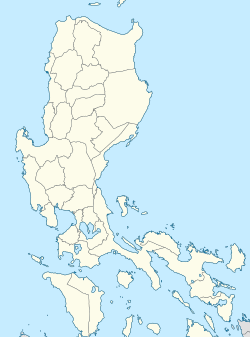
Lipa, officially the City of Lipa, is a component city in the province of Batangas, Philippines. According to the 2020 census, it has a population of 372,931 people.

San Jose, officially the Municipality of San Jose, is a municipality in the province of Batangas, Philippines. According to the 2020 census, it has a population of 79,868 people.

The Archdiocese of Lipa is a Latin Church ecclesiastical territory or archdiocese of the Catholic Church in the Philippines comprising the civil province of Batangas. Its cathedral is the Metropolitan Cathedral of St. Sebastian located in Lipa, Batangas. First created on April 10, 1910 from the Archdiocese of Manila, the diocese was elevated into its present status on June 20, 1972. Today, the Archdiocese of Lipa's ecclesiastical province covers Batangas and the suffragan territories in the civil provinces of Quezon, Marinduque, and Aurora. The archdiocese itself is divided into 14 vicariates forane further comprising a total of 65 parishes.
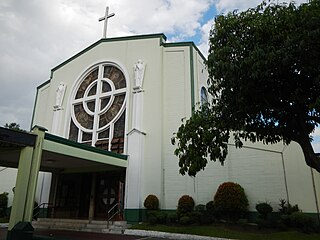
Santuario de San José Parish is a parish church found inside the Green Hills East Village in Mandaluyong, Philippines. It is designated as the Shrine of Saint Joseph the Patriarch, and is under the jurisdiction of the Archdiocese of Manila. The church is run by the Oblates of St. Joseph (OSJ). It is the home parish of different chapels: the Holy Family Chapel and the two chapels of Crame, Immaculate Conception and Sacred Heart.
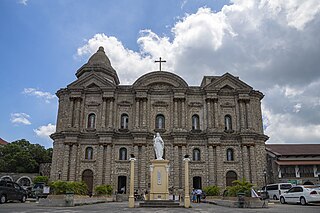
The Minor Basilica and Parish of Saint Martin of Tours, commonly known as Taal Basilica, is a minor basilica in the town of Taal, Batangas, within the Archdiocese of Lipa. It is considered to be the largest church building in the Philippines and in Asia, standing 88.6 meters (291 ft) long and 48 meters (157 ft) wide. Martin of Tours is the patron saint of Taal, whose feast is celebrated every November 11.

The National Shrine of the Our Lady of Candles, also known as the Metropolitan Cathedral of Saint Elizabeth of Hungary and colloquially as Jaro Cathedral, is a cathedral located in the district of Jaro in Iloilo City, on the island of Panay in the Philippines. The seat of the Roman Catholic Archdiocese of Jaro, it was placed under the patronage of Saint Elizabeth of Hungary. It was established in 1575 as a visita (chapel-of-ease) of Oton by the Augustinians and as a separate parish in 1587. The present-day structure of Jaro Cathedral was built in 1874.

Santa Monica Parish Church, commonly known as Minalin Church, is a Baroque Roman Catholic church, located in poblacion area of San Nicolas in Minalin, Pampanga, Philippines. The church, built during the Spanish era, was declared a National Cultural Treasure by the National Commission for Culture and the Arts and the National Museum of the Philippines on August 27, 2011, one of 37 churches in the country bestowed that honor.
The Archdiocesan Shrine of Señor Santo Niño is the Roman Catholic parish and archdiocesan shrine located in Midsayap, North Cotabato, Philippines. It is under the ecclesiastical jurisdiction of the Archdiocese of Cotabato. Santo Niño Parish is the oldest parish church established by the missionary congregation of the Oblates of Mary Immaculate in 1939.

The Archdiocesan Shrine of Saint John the Baptist, known colloquially as Pinaglabanan Church, is a 19th-century Roman Catholic church in San Juan, Metro Manila, Philippines. It belongs to the Archdiocese of Manila.

The Archdiocesan Shrine of Our Lady of Caysasay is a coral-hewn Roman Catholic chapel in Barrio Caysasay in Taal, Batangas, belonging to the Archdiocese of Lipa in the Philippines. It was built in 1639 by Fr. Alonso Rodriguez to replace a temporary structure built in 1611. The church is home to Our Lady of Caysasay whose feast day is celebrated every December 8.

The Minor Basilica and Parish of the Immaculate Conception, alternatively known as the Archdiocesan Shrine of Santo Niño de Batangan, is a minor basilica in Batangas City, Philippines. It is under the jurisdiction of the Archdiocese of Lipa. It was made an independent parish in 1614 under the advocation of the Immaculate Conception. It is one of the oldest churches in Batangas.
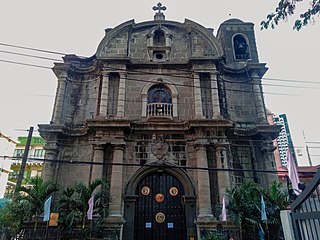
Saints Peter and Paul Parish Church, also known as San Pedro Macati Church, Sampiro Church, Makati Church, is a Roman Catholic church located in Makati Poblacion, the cultural and heritage barangay of Makati, Philippines. It is under the jurisdiction of the Archdiocese of Manila. It is considered as the mother church of Makati. In front of the church façade is Plaza Cristo Rey, which was formerly the San Pedro de Macati Cemetery. The National Museum of the Philippines designated the church an Important Cultural Property in 2023.

The Archdiocesan Shrine of the Blessed Sacrament, also known as the Our Lady of the Pillar Church or simply Santa Cruz Parish, is a Mission Revival Roman Catholic parish church in the district of Santa Cruz, Manila, Philippines. It is under the jurisdiction of the Archdiocese of Manila. The church was built when the arrabal (suburb) of Santa Cruz was established by the Jesuits in the early 17th century. The church had undergone many repairs and reconstruction, with the last reconstruction done in the 1950s.

The Archdiocesan Shrine and Parish of Saint Joseph the Patriarch, also known as Saint Joseph the Patriarch Church, is a Roman Catholic church located in the town center of San Jose, Batangas, in the Philippines. It is under the jurisdiction of the Archdiocese of Lipa. The church is known for being one of the parishes that Fr. Manuel Blanco OSA, who authored the Flora de Filipinas, administered.
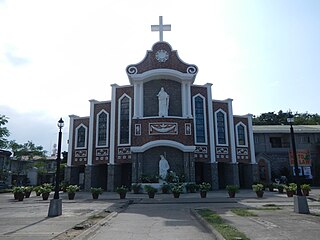
San Roque Parish Church, also known as Saint Roch Parish Church and Lemery Church, is a Roman Catholic church in the municipality of Lemery, Batangas, in the Philippines. It is under the jurisdiction of the Archdiocese of Lipa. Dedicated to St. Roch and to the Our Lady of Divine Grace as its secondary patron, the fiesta is celebrated every August 16 in honor of St Roch. The feast of the Our Lady of Divine Grace is celebrated every August 15, with the traditional "Pagsundo sa Birhen" held every year in Barangay Wawa. The parish became independent from Taal by the order of Manila's archbishop on May 12, 1868. The parish had recently celebrated its 150th anniversary last 2018.

The Parish and National Shrine of Saint Padre Pio, commonly known as Padre Pio Shrine, is a Roman Catholic parish church and pilgrimage site situated along Governor Antonio Carpio Avenue in Barangay San Pedro, Santo Tomas, Batangas, Philippines. It is consecrated to the Italian Saint Pio of Pietrelcina.

Our Lady of the Rosary Parish is a Catholic church in Rosario, Batangas, Philippines. It is part of Vicariate IX: The Vicariate of Our Lady of the Holy Rosary of the Roman Catholic Archdiocese of Lipa. The church is located at J Belen Street corner Gualberto Avenue in Poblacion B. It is the second church of Rosario after the Most Holy Rosary Parish located in Lumang Bayan, the present-day Padre Garcia, Batangas.

Saint Michael the Archangel Parish Church, commonly known as Lobo Church, is a Neo-classic parish church in the municipality of Lobo, Batangas in the Philippines. The church is under the jurisdiction of the Roman Catholic Archdiocese of Lipa. The parish is dedicated to Saint Michael and its feast day is celebrated every May 8. The church was founded in 1873 while the current building was built in 1980 to 1986.

San Juan Nepomuceno Parish Church is a Roman Catholic church in San Juan, Batangas, Philippines. It is under the jurisdiction of the Archdiocese of Lipa. Located at Padre Burgos Street in Poblacion, adjacent to three schools: Batangas Eastern Colleges, Joseph Marello Institute, and San Juan Elementary School, this is the second church of San Juan after the old church ruins, located in Pinagbayanan, which was destroyed by floods in 1883.

